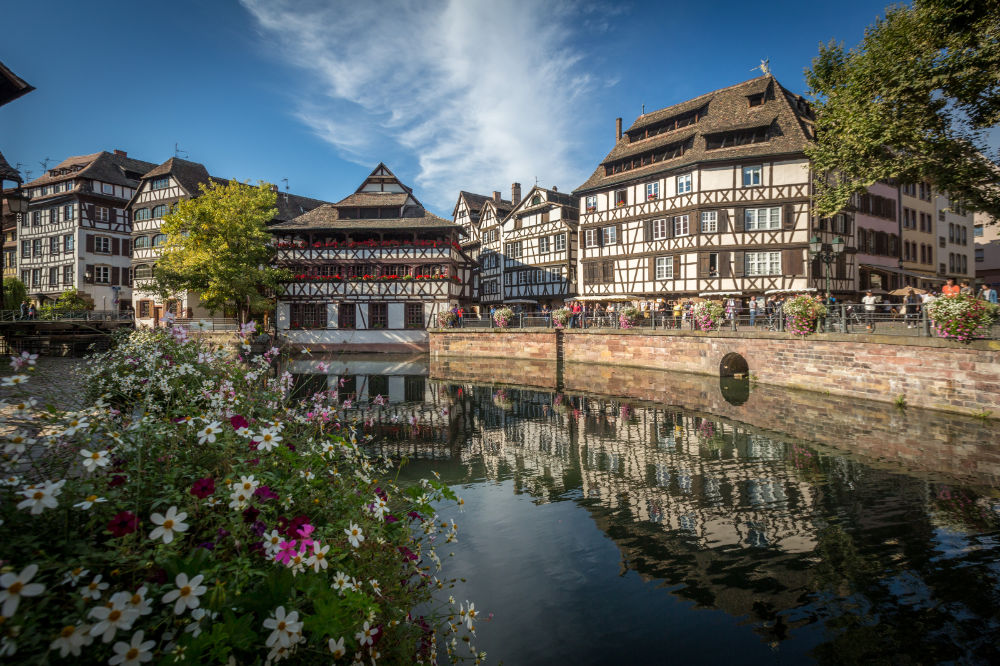
Strasbourg
Strasbourg, the capital of the Alsace region in northeastern France, is a city of incredible beauty and deep historical significance. Nestled along the banks of the River Ill, near the border with Germany, Strasbourg has long served as a crossroads of cultures, blending French and German influences into a unique and charming destination. Its well-preserved medieval architecture, rich cultural heritage, and status as a center of European politics make Strasbourg a must-visit city for travelers seeking both history and modern vibrancy.
A Rich Historical Tapestry: From Medieval Roots to European Capital
Strasbourg’s history stretches back over 2,000 years, originally founded by the Romans as a military outpost called Argentoratum. Its strategic location along the Rhine River and on the crossroads of major trade routes made Strasbourg a vital center throughout the Middle Ages. The city flourished as a hub for trade and learning, especially during the Renaissance, when it became a focal point for humanist thinkers and the printing revolution.
Over the centuries, Strasbourg was repeatedly contested between France and Germany, shifting control multiple times. This unique Franco-Germanic heritage is reflected in the city’s architecture, culture, and even its language. After World War II, Strasbourg became a symbol of reconciliation and peace, housing the European Parliament, Council of Europe, and European Court of Human Rights, making it one of Europe’s de facto capitals.
Top 5 Unique Characteristics of Strasbourg
1. The Strasbourg Cathedral
One of the most striking landmarks in Europe, the Cathédrale Notre-Dame de Strasbourg is a masterpiece of Gothic architecture. Completed in 1439, this towering cathedral was the tallest building in the world for over 200 years. Its intricate façade, adorned with hundreds of sculptures, and the stunning rose window are marvels of medieval craftsmanship. Inside, visitors can admire the remarkable astronomical clock, which was built in the 16th century and still performs a daily show. The cathedral's observation deck offers breathtaking views of Strasbourg and the surrounding countryside.
2. La Petite France: A Fairytale Quarter
Wandering through La Petite France, the city’s most picturesque district, is like stepping into a storybook. This historic quarter, once home to tanners, fishermen, and millers, is famous for its half-timbered houses with colorful facades, narrow cobblestone streets, and canals. The area is crisscrossed by bridges and walkways, providing stunning views of the medieval buildings reflected in the water. The quaint charm of La Petite France makes it one of Strasbourg’s most beloved neighborhoods for both locals and tourists.
3. European Political Center
Strasbourg’s modern-day importance is reflected in its status as a center for European governance. The city is home to the European Parliament, which represents the voice of EU citizens and plays a key role in shaping European policies. Strasbourg also hosts the Council of Europe and the European Court of Human Rights, underscoring its role as a symbol of European unity and peace. Visitors can tour the European Parliament building, gaining insight into the workings of the EU and the city’s global significance.
4. Alsatian Cuisine: A Blend of French and German Flavors
Strasbourg’s cuisine is a delightful fusion of French and German influences, resulting in unique dishes that reflect the city’s multicultural heritage. Choucroute garnie (sauerkraut with sausages and pork), tarte flambée (a thin, crispy flatbread with cream, onions, and bacon), and bäckeoffe (a slow-cooked meat and vegetable stew) are just a few of the local specialties to try. Don’t miss out on sampling the local wines, especially Riesling and Gewürztraminer, which are grown in the nearby Alsace vineyards.
5. Christmas Markets: A Winter Wonderland
Strasbourg is known as the "Capital of Christmas" thanks to its world-famous Christkindelsmärik, one of the oldest and most beautiful Christmas markets in Europe. Held annually since 1570, the market transforms the city’s squares into a festive wonderland with twinkling lights, wooden stalls selling handcrafted gifts, and the smell of mulled wine and gingerbread filling the air. Visitors from around the world flock to Strasbourg during the holiday season to experience its magical atmosphere and centuries-old traditions.
Strasbourg Today: A City Where History Meets Modern Europe
Strasbourg’s blend of historical charm and modern significance makes it one of the most dynamic cities in Europe. As the seat of key European institutions, it plays a crucial role in shaping the future of the continent. Meanwhile, the city continues to honor its heritage with well-preserved medieval architecture, thriving arts and culture, and a strong commitment to preserving its unique identity.
Modern-day Strasbourg is also a green and bike-friendly city, with miles of cycling paths and a commitment to sustainability. Its location at the heart of Europe, along with its mix of French and German influences, makes Strasbourg an exciting and vibrant destination for travelers of all kinds.
Fun Facts About Strasbourg
The Strasbourg Cathedral was the tallest building in the world from 1647 to 1874, and it remains one of the tallest churches in the world today.
Strasbourg is home to one of the oldest universities in France, founded in 1538, making it a key center for learning during the Renaissance.
The famous La Marseillaise, the French national anthem, was first sung in Strasbourg in 1792.
Strasbourg has been a UNESCO World Heritage Site since 1988, thanks to its well-preserved historical center known as the Grande Île.
Strasbourg’s location on the Ill River means it is often referred to as the "Venice of the North" for its many scenic canals.
Whether you’re exploring its Gothic cathedral, tasting Alsatian cuisine, or delving into European history, Strasbourg offers a rich cultural experience that blends the best of the past and the future. This vibrant, multicultural city invites you to discover its unique charm and significance at the heart of Europe.